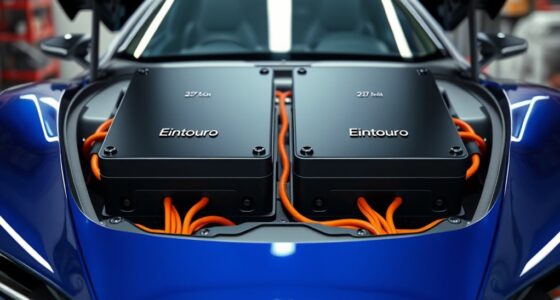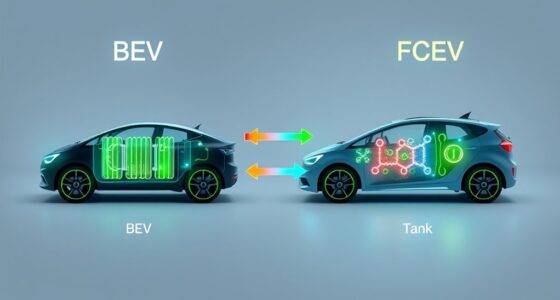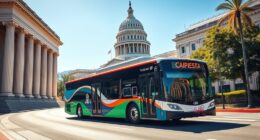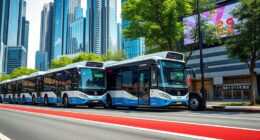If you’re choosing between LFP and NMC batteries for transit, consider your priorities. LFP offers better safety, longer lifespan, and lower upfront costs, making it ideal for long-term, budget-conscious projects. NMC provides higher energy density and faster charging, which suits high-performance applications requiring lighter and more powerful batteries. To find out which chemistry best fits your transit needs and how technological advances impact them, explore further to get the full picture.
Key Takeaways
- LFP batteries offer longer lifespan (3,000–5,000 cycles) and better safety, ideal for long-term transit applications.
- NMC batteries provide higher energy density and faster charging, suitable for high-performance or lightweight transit needs.
- LFP’s lower upfront cost and durability lead to reduced total ownership costs over time.
- NMC’s higher initial cost is offset by superior performance and energy density for specific transit requirements.
- Choice depends on whether longevity and safety (LFP) or energy density and quick charging (NMC) are prioritized.

When choosing between LFP and NMC batteries, understanding their key differences can help you make an informed decision. Both chemistries power many transit solutions, but they have distinct advantages and limitations that impact your overall experience. One of the main factors to contemplate is battery lifespan. LFP batteries generally last longer, often providing 3,000 to 5,000 charge cycles, which translates into around 10 to 15 years of service life. They maintain their capacity well over time, making them a reliable choice for applications that require durability and long-term performance. In contrast, NMC batteries typically offer fewer charge cycles—around 1,000 to 2,000—though they tend to deliver higher energy density, meaning they can store more power in a smaller, lighter package. If longevity is your priority, LFP’s extended lifespan can lead to lower replacement costs and less frequent maintenance, ultimately saving you money over time.
Cost comparison is another critical aspect when weighing these chemistries. LFP batteries usually come at a lower upfront cost per kilowatt-hour, making them attractive if you’re budget-conscious or aiming for large-scale deployment. Their simpler chemistry and manufacturing process contribute to this affordability, and since they last longer, the total cost of ownership often favors LFP over time. NMC batteries are more expensive initially because of their more complex chemistry and higher energy density. However, their ability to deliver more power and longer range in fewer cells might justify the higher price for certain applications, such as high-performance transit vehicles or those requiring lightweight designs. Still, in the long run, the shorter lifespan of NMC batteries could mean more frequent replacements, which can add to your overall costs. Additionally, advancements in battery management systems continue to improve the safety and efficiency of both chemistries, influencing long-term performance and maintenance considerations.
When contemplating your transit needs, it’s essential to weigh these factors carefully. If your priority is long-term durability and lower total ownership costs, LFP batteries often come out ahead. They’re more stable, safer, and more cost-effective over their lifespan. On the other hand, if you need high energy density and faster charging for shorter trips or lighter vehicles, NMC batteries might be more suitable despite their higher initial expense and shorter lifespan. Ultimately, your decision will depend on how you balance upfront costs, longevity, performance, and maintenance needs. By understanding these differences, you can choose the chemistry that best aligns with your transit goals and budget.
Frequently Asked Questions
How Do LFP and NMC Batteries Compare in Cost?
You’ll find that LFP batteries generally have a lower cost comparison than NMC batteries due to their simpler manufacturing processes and cheaper raw materials. Manufacturing costs for LFP are typically less, making them more affordable upfront. However, NMC batteries often provide higher energy density, which can justify their higher price in certain applications. Overall, if cost is your primary concern, LFP batteries usually offer a more budget-friendly option.
What Are the Environmental Impacts of Each Battery Type?
You should know that LFP batteries have a lower environmental impact, with 50% less cobalt use than NMC batteries, reducing concerns around mineral sourcing. Both types can be recycled, but LFP’s simpler chemistry makes recycling more efficient. NMC batteries, however, require careful disposal due to toxic materials. By choosing LFP, you help minimize harmful mining and support better battery recycling practices, making it the more eco-friendly option overall.
Which Battery Type Offers Better Safety Features?
You’ll find that LFP batteries offer better safety features due to their lower battery fire risk and superior thermal stability. They’re less prone to overheating or thermal runaway, reducing the chance of fires. NMC batteries, while more energy-dense, pose a slightly higher risk of thermal instability. For transit applications prioritizing safety, LFP batteries provide a more reliable choice, especially in demanding environments where thermal management is critical.
How Do Temperature Ranges Affect Battery Performance?
You might think batteries love the heat, but in reality, temperature ranges can make or break their performance. When you stay within their operating limits, batteries maintain thermal stability and deliver consistent power. Push them beyond, and you risk overheating or rapid degradation. So, keep an eye on temperature, because thermal stability isn’t just a fancy term — it’s your battery’s best friend, ensuring safety and longevity.
What Is the Typical Lifespan of LFP Versus NMC Batteries?
You’ll find that LFP batteries typically last around 2,500 to 5,000 cycles, offering a longer lifespan and easier battery recycling. NMC batteries generally last about 1,000 to 2,000 cycles, with higher energy density but shorter life. This difference impacts maintenance and sustainability, as longer-lasting LFP batteries reduce waste and improve recycling efficiency, while NMC’s higher energy density benefits range but may need earlier replacement.
Conclusion
When choosing between LFP and NMC batteries, it’s clear there’s no one-size-fits-all answer. Both have their strengths, but you’ll want to weigh factors like cost, range, and safety based on your transit needs. Remember, it’s not just about finding the perfect fit but making an informed decision. In the end, it’s all about playing your cards right—you’ll find the best battery chemistry that keeps your transit running smoothly and efficiently.









